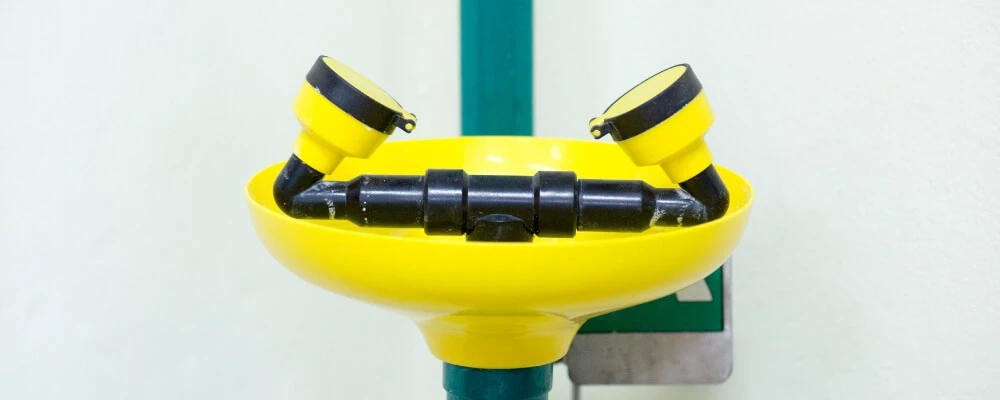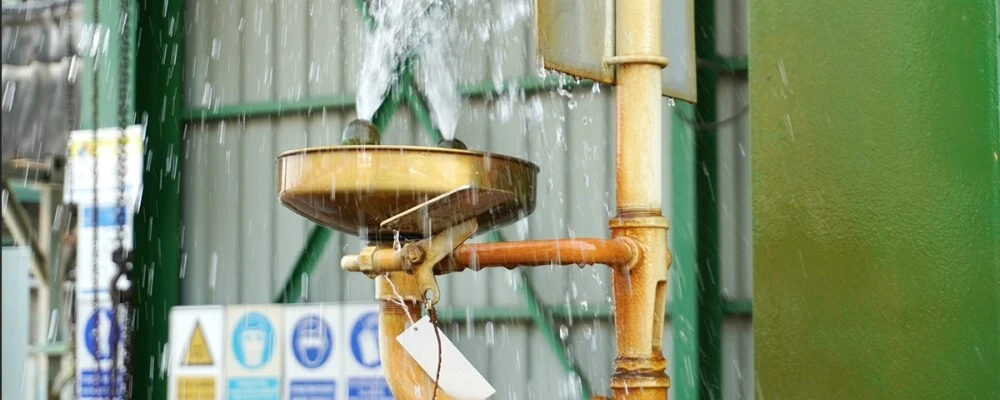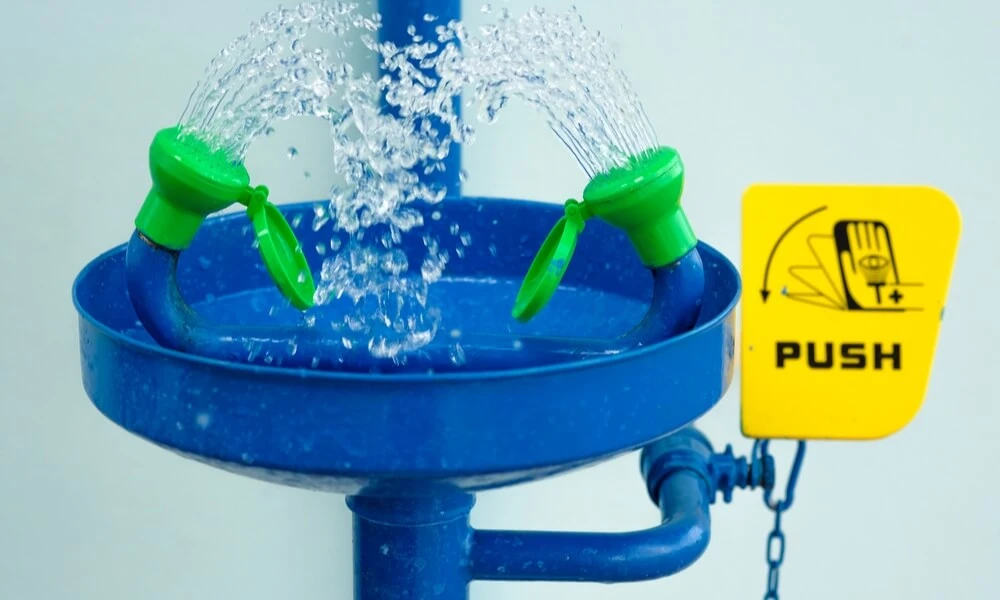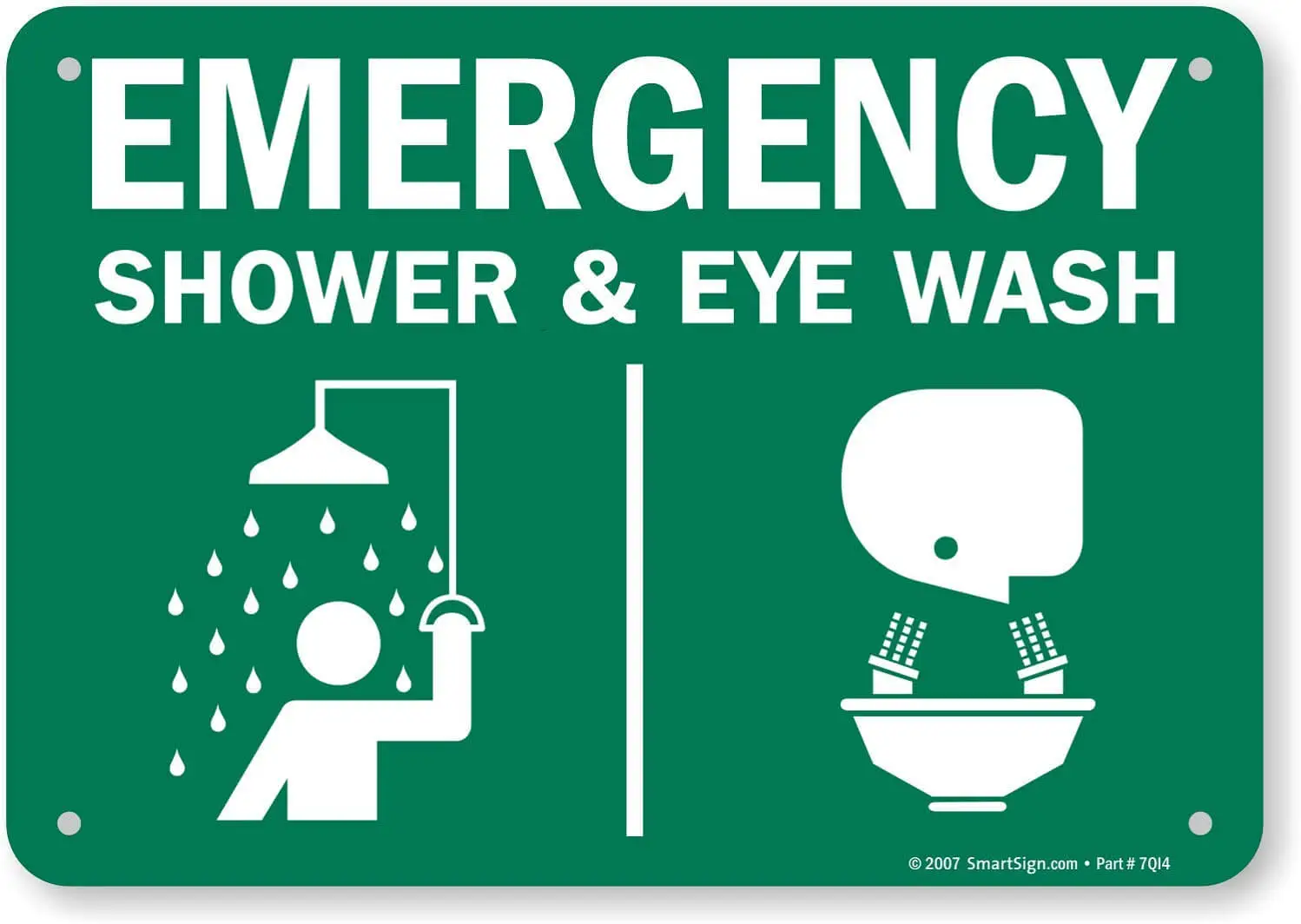In today’s dynamic work environments, safety measures are more crucial than ever. Among these protective measures, the “Emergency Eyewash Station” stands out as a critical safeguard for workers who may encounter harmful chemicals or contaminants. But what exactly is this station, and why is it so pivotal? Moreover, how does one recognize and correctly utilize one during emergencies?
Dive into this blog as we unpack the nuances of the Emergency Eyewash Station, explore the importance of its signage, and guide you step-by-step on how to use it effectively. Whether you’re a seasoned professional or new to an industry with potential eye hazards, this comprehensive guide will be your compass to eye safety.
What is Emergency Eyewash Station?
An emergency eyewash station is a crucial safety device designed to douse or flush out the eyes in the event that they are exposed to harmful chemicals or contaminants. These stations provide immediate decontamination, allowing workers to flush away hazardous substances that can cause injury. They are essential in laboratories, factories, and other workplaces where chemicals are used or produced.
Here are some key characteristics and components of emergency eyewash stations:
- Flow of Fluid: The station simultaneously delivers a controlled flow of a prescribed fluid to both eyes. This fluid can be water or a specific eyewash solution, depending on the station type and the potential contaminants in the area.
- Activation: Eyewash stations are designed for hands-free operation once activated. This ensures users can flush their eyes without holding a lever or button.
- Duration: To be compliant with safety standards, such as those set by the American National Standards Institute (ANSI), the eyewash station must be able to deliver the flushing fluid for at least 15 minutes.
- Accessibility: The eyewash station should be positioned in a location that can be reached within 10 seconds (roughly 55 feet) of the hazard. The pathway to the station should be clear of obstructions.
- Maintenance: Regular inspections are required to ensure the station operates correctly. This might include checking the fluid flow, ensuring no sediment buildup in the fluid reservoir, and verifying that the station activates properly.
- Identification: Eyewash stations should be clearly marked and easily identified, often with a sign featuring an eye symbol. Proper lighting should ensure that the station is visible even in low-light conditions.
- Training: Workers should be trained on the location of eyewash stations, how to use them, and the importance of seeking medical attention after use.
These stations are integral to a comprehensive workplace safety plan, especially in environments with a risk of chemical exposure to the eyes.

Importance Of Having An Eyewash Station
An eyewash station is an indispensable safety feature in settings where there’s potential exposure to harmful chemicals or contaminants. Here’s an explanation of its importance:
- Immediate Response to Eye Injuries: The eyes are particularly sensitive and susceptible to damage from chemical splashes or foreign particles. Having an eyewash station offers a first line of defense by providing immediate access to a flushing mechanism, which can significantly reduce the severity of an injury.
- Prevention of Long-term Damage: Swift action can mean the difference between a temporary injury and permanent vision loss. Certain chemicals can cause immediate and irreparable harm to the eyes, so timely and adequate flushing is crucial. An eyewash station facilitates this rapid response.
- Enhanced Workplace Safety: The presence of an eyewash station sends a clear message about an organization’s commitment to safety. It not only provides a means to address emergencies but also fosters a safety-conscious culture.
- Compliance with Safety Regulations: In many countries and regions, the presence of eyewash stations is mandated by law or regulations, especially in labs, factories, or any setting where hazardous chemicals are handled. Compliance helps avoid legal consequences and potential liability issues.
- Reduction in Workdays Lost: Timely intervention after an eye injury can lead to quicker recovery, thereby reducing the number of workdays lost due to injury. This is beneficial for both the employee’s well-being and the organization’s productivity.
- Cost Savings: While there’s an initial cost in installing and maintaining eyewash stations, they can lead to significant savings in the long run by potentially preventing expensive medical treatments, legal battles, or compensation for affected employees.
- Versatility for Different Incidents: Apart from chemical splashes, eyewash stations can also be useful for rinsing out eyes exposed to dust, smoke, or other irritants commonly found in various work environments.
- Boosted Employee Morale: Knowing that safety measures are in place increases employee confidence and morale. Workers are more likely to feel valued and protected when they know that their well-being is a priority.
- Encouraging Best Practices: The mere presence of an eyewash station serves as a constant reminder to employees about the potential risks and the importance of following safety protocols.
- Providing a Comprehensive Safety Approach: When combined with other safety measures, such as protective eyewear, gloves, and safety training, eyewash stations contribute to a comprehensive approach to workplace safety.
In essence, while we hope never to have to use an eyewash station, its presence is essential for ensuring the safety and well-being of those working around hazardous substances or environments.

How To Use An Emergency Eye Wash Station?
Using an emergency eyewash station properly can be crucial to preventing serious eye injury. Here’s a step-by-step explanation on how to use one:
1. Immediate Action
When hazardous materials come into contact with your eyes, time is of the essence. Chemical reactions can begin almost instantly, and the longer contaminants remain, the greater the potential for serious injury. Acting swiftly reduces the risk of lasting damage and increases the chances of a full recovery.
2. Proceed to the Station
The location of the eyewash station is strategic. Being within a 10-second walk, roughly equivalent to 55 feet, ensures that you can access it promptly after exposure. This proximity is vital because delayed treatment can result in complications. Before you handle chemicals, familiarize yourself with the path to the eyewash station, and always ensure it’s unblocked. This helps in reaching the station quickly during emergencies.
3. Activate the Unit
Eyewash stations are designed for ease of use, especially when in distress. A simple lever or button initiates the flow of the flushing fluid, typically water. Once activated, the station operates hands-free, which is beneficial because you can use both hands to hold your eyes open, ensuring thorough cleansing.
4. Flush the Eyes
Opening your eyes wide is crucial for effective flushing. By using your thumbs and forefingers, you expose more surface area of the eye to the fluid. Positioning your face correctly means the fluid will flow from the forehead and across the eyes, preventing contaminants from running down your face and into the eyes. To ensure that every part of the eye and the area underneath the eyelids is cleaned, move your eyeballs in all directions. A continuous flush for 15 minutes is essential to dilute and remove chemicals comprehensively.
5. Contact Lenses
Contact lenses can trap chemicals against the cornea, increasing the risk of injury. If you’re wearing them during an incident, removing them during the flushing process ensures that the fluid directly reaches the surface of the eye. However, prioritizing immediate flushing over removing lenses is essential as the primary goal is to minimize the chemical’s contact time with the eyes.
6. Continue Flushing
The recommended 15-minute flush duration is based on the time typically required to neutralize and remove harmful chemicals. Stopping early, even if discomfort eases, might not effectively rinse away all contaminants, leaving residues that can cause injuries later.
7. Seek Medical Attention
Post-flushing, medical examination is paramount. Some chemicals cause injuries that manifest over time, and initial relief doesn’t guarantee that damage hasn’t occurred. Refrain from touching or rubbing your eyes as this can exacerbate the injury. Taking the chemical container or its label helps medical professionals determine the best treatment approach.
8. Document the Incident
Informing your supervisor about the incident ensures that appropriate actions, such as reviewing safety protocols or retraining staff, are taken to prevent future occurrences. Proper documentation serves as a record for workplace safety compliance and can be useful for medical follow-ups.
Emergency Eyewash Station Signs
Emergency Eyewash Station signs are essential visual cues in a workplace that guide individuals to eyewash facilities in the event of an eye-related emergency. Ensuring that these signs are visible, easily recognizable, and clearly indicate the location and direction of the eyewash station is paramount for swift and effective response to incidents. Here’s a breakdown of their characteristics and importance:
Design and Visibility:
- Color: Typically, eyewash station signs are green and white, universally recognized colors for safety and first aid information.
- Iconography: A common icon is an eye symbol combined with flowing water, signaling the flushing process.
- Text: Clear, bold lettering with the words “Emergency Eyewash Station” should be prominently displayed.
Placement:
- Above the Station: The most effective place for a sign is directly above the eyewash station, ensuring it’s visible from a distance.
- Directional Indicators: In large facilities, additional signs leading to the station can be strategically placed, guiding individuals towards it.
Importance:
- Quick Identification: In emergencies, time is of the essence. Clear signage helps individuals rapidly locate and move towards the eyewash station.
- Safety Compliance: Meeting OSHA and ANSI standards, among others, is essential for workplace safety compliance. Proper signage is a key component of these standards.
- Training and Familiarity: Regular safety drills and training sessions can familiarize employees with the signage, ensuring they know exactly where to go when an emergency arises.

Emergency Eyewash Station: Standards and Regulations
Standards and regulations ensure the safety and health of workers across various industries. Here’s an overview of some prominent standards related to eyewash stations:
Occupational Safety and Health Administration (OSHA) Requirements:
The Occupational Safety and Health Administration (OSHA) is a U.S. federal agency tasked with ensuring that employees work in safe conditions. Pertaining to eyewash stations, OSHA’s 29 CFR 1910.151(c) mandates that in areas where workers’ eyes or bodies might be exposed to corrosive materials, facilities capable of quickly drenching or flushing the eyes and body must be provided for immediate emergency use. While OSHA lays out this requirement, it often leans on the specifics provided by ANSI to define what “suitable” facilities mean.
American National Standards Institute (ANSI) Guidelines:
The American National Standards Institute (ANSI) is a non-profit organization that formulates consensus standards for various domains in the U.S. For emergency eyewash and shower equipment, the ANSI/ISEA Z358.1 is a pivotal standard. It elucidates several specifics: eyewash stations should provide a tepid flushing fluid; they need to be situated within a 10-second walk, which is approximately 55 feet, from hazardous areas; the station must deliver the fluid at a minimum rate of 0.4 gallons per minute and this should last for a minimum of 15 minutes; activation of the eyewash station should be possible in a second or less and once activated, it should function hands-free. Furthermore, it’s emphasized that such stations should be installed in areas with adequate lighting, and there should be clear signage indicating their presence.
Other International Standards:
Internationally, standards vary based on region and local governing bodies. In Europe, the standard that holds sway is the European Standard EN 15154. This is dedicated to emergency safety showers, eye washes, and eye/face wash units. Moving to Australia, they abide by the AS 4775-2007, which elaborates on the performance, installation, and utilization of emergency eyewash and shower equipment. Germany has its distinct standard for eyewash stations named DIN 12899. It meticulously defines the demands and testing for eye showers, ensuring they are apt for workplaces and various industrial scenarios.
It’s of paramount importance for entities to acquaint themselves with and strictly adhere to the standards and regulations relevant to their geographical region and industry. Conducting regular assessments ensures that the eyewash stations and related safety equipment are maintained at par with the established standards, ensuring their efficacy during emergencies.

Emergency Eyewash Station Maintenance and Inspection
Maintenance and inspection of emergency eyewash stations are crucial to ensuring that they function correctly during an emergency. Here’s a guide on how to maintain and inspect them:
Routine Inspection:
- Frequency: Weekly inspections are advisable. These inspections ensure that the station is free from obstructions and can provide clean, potable water or flushing fluid. Some systems, especially those using solutions other than water, may have different maintenance and inspection intervals, so always consult the manufacturer’s guidelines.
- Accessibility: Check that the path to the eyewash station is clear from any obstructions. It should be easy to reach and activate in an emergency.
- Cleanliness: The eyewash station should be clean and free from dust or debris. This is particularly essential for tank-fed eyewash stations that don’t use a continuous water supply.
Detailed Quarterly Inspection:
- Activation: Activate the eyewash station to ensure it functions correctly. Ensure that it can be activated within one second and operates hands-free thereafter.
- Flow Rate: Check the flow rate to ensure it aligns with standard requirements (usually 0.4 gallons per minute). The flow should be steady, and the water should drain properly, without pooling.
- Water Quality: If the system uses water, the quality should be potable. It should be clear, without any sediments or contaminants. Some stations come equipped with filters; these should be checked and replaced as needed.
- Fluid Temperature: If the system is designed to deliver tepid water, the temperature should be checked to ensure it’s within the recommended range (typically between 60°F and 100°F or 15°C and 37°C).
- Duration: Ensure the station can deliver flushing fluid for the required duration, typically 15 minutes.
Annual Maintenance:
- Full Activation Test: Conduct a more extensive test by activating the unit for the full recommended flushing period (usually 15 minutes). This not only checks the operation but can also help to flush out any sediments or contaminants.
- Parts and Seals: Inspect all components like hoses, nozzles, valves, and seals for signs of wear or damage. Replace any parts as necessary.
- Expiration: If the system uses a solution with an expiration date, ensure it’s within the valid period. Expired solutions must be replaced immediately.
- Training: Use the annual maintenance period as an opportunity to refresh training for all workers. Ensure they know how to operate the eyewash station and understand its importance.
Documentation:
Always document each inspection and maintenance activity. This record-keeping is crucial for compliance purposes and ensures that any recurring issues or patterns can be identified and addressed.
Conclusion
In the labyrinth of workplace safety protocols, the Emergency Eyewash Station emerges as a beacon of protection against eye injuries and potential blindness. Understanding its function, recognizing its signage, and mastering its usage are not mere formalities, but essential skills in ensuring a quick and effective response during emergencies. As we’ve navigated through its intricacies, it’s clear that this station is more than just a fixture; it’s a lifeline.
Prioritizing its presence and promoting its proper use is not only a testament to an organization’s commitment to safety but also an investment in the well-being of its most valuable asset: its people. As you step forward, always remember that knowledge is the key, and in the world of eye safety, a few seconds at the eyewash station can make a lifetime of difference.





